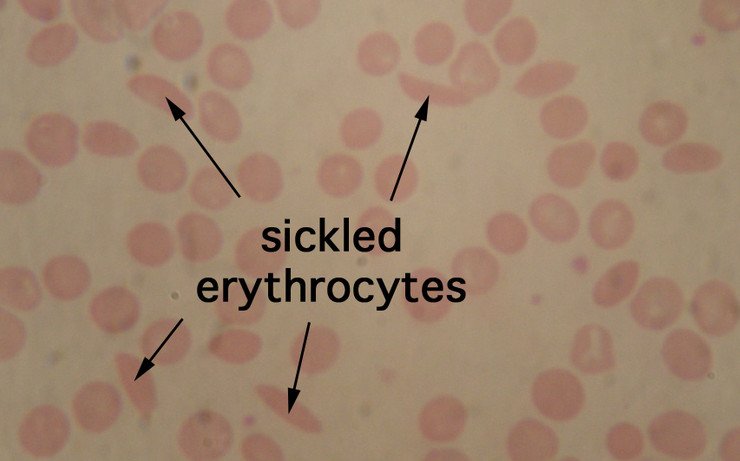What is Sickle Cell Anemia ?
Sickle cell anemia is a severe, chronic, autosomal genetic blood disorder characterized by abnormal red blood cells. Normally, the red blood cells contain an iron-rich protein known as hemoglobin, which is responsible for carrying oxygen to the different cells in the body.
However, in sickle cell anemia, the abnormal hemoglobin is distorted and resembles rigid and sickle shaped or crescent-liked erythrocytes. Fragility among the red blood cells is increased but flexibility is decreased thereby resulting in various complications. In addition, these cells tend to clog the blood flow of blood vessels causing pain and organ damage. This is also called a sickle cell crisis or a vaso-occlusive crisis and mostly occurs in children.
Causes of Sickle Cell Anemia
Sickle anemia is caused by a genetic mutation of hemoglobin S. This condition is most prevalent among inhabitants of tropical and subtropical regions. Hemoglobin S is usually characterized by fragile, sickle shaped red blood cells which could lead to poor delivery of oxygen to the different tissues in the body.
In addition, the shape of the red blood cells enables it to become easily stuck in small blood vessels thereby interrupting the blood flow. It would take two parents who are both positive for the sickle cell trait to have their offspring test positive for sickle cell anemia. Meanwhile, individuals with the sickle cell trait do not usually have any symptoms and could have normal life expectancies.
Signs and Symptoms of Sickle Cell Anemia
- Do not usually appear until after 4 months old
- Characterized by a sickle cell crisis
- Result of vaso-occlusive crisis, aplastic crisis, splenic-sequestration crisis and hemolytic crisis
- In vaso-occlusive crisis, there is a blockage or obstruction in the blood flow due to misshapen Hemoglobin S. Patients may experience organ ischemia, pain and eventually necrosis. Meanwhile, aplastic crisis indicates worsening of anemia. Tachycardia, pallor and fatigue may be the usual symptoms. In splenic-sequestration, the spleen is usually the organ which is affected most resulting in the enlargement of the organ. This type of crisis usually requires emergency treatment because it is a high risk for circulatory failure. Lastly, hemolytic crisis occurs when the red blood cells breakdown faster than normal. This condition has been greatly associated with G6PD or glucose-phosphate deficiency.
- Generally, the symptoms experienced by the patient once anemia becomes severe are shortness of breath, fatigue, pallor, and increased heart rate as well as a yellow or sallow discoloration of the skin. Pain experienced could be severe and may require hospitalization. The bones of the back, chest and long bones are usually the most sensitive body parts. Some children may also experience abdominal pain.
- Once the organs are already affected, specific symptoms may already become apparent depending on the organs involved. Visual loss, painful and prolonged erection, confusion and ulcers are some of these symptoms.
- Bone infection, pneumonia, cholecystitis or the inflammation of the gallbladder could also result as complications especially after the spleen becomes damaged. Arthritis, delayed growth and puberty are also possible.
Diagnosis
- A blood smear test may be done to detect and quantify the types of hemoglobin present.
- A hemoglobin electrophoresis test may be required to confirm the type of hemoglobin in the blood.
- Other diagnostic tests that may also be necessary are complete blood count, blood oxygen, bilirubin, serum creatinine and potassium as well as sickle cell test.
Sickle Cell Anemia histology picture

picture : sicked erythrocytes
image source : cord.edu
Treatment for Sickle Cell Anemia
Unfortunately, there is no cure for the condition. Treatments are usually palliative and aim to improve anemia as well as prevent further damage and complications. Other goals would include pain management, prevention of infection and possible stroke.
- Fatigue and anemia brought about by sickle cell anemia are usually managed with blood transfusions to restore hemoglobin within normal levels. Blood transfusions, however, has its risks and these include blood borne diseases like hepatitis, allergic reactions, infections and iron overload.
- Pain management would include over the counter drug preparations if the pain is not too severe as well as plenty of fluids and adequate rest. However, pain may need to be managed in a hospital setting once it becomes too severe. Acetaminophen (Tylenol) or nonsteroidal anti-inflammatory drugs (NSAID) are the medications given for mild to moderate pain. Opioids would become the drug of choice for extremely severe pain. Adequate hydration is also necessary as well as oxygen therapy if the oxygen saturation becomes too low.
- Hydroxyurea is a medication given to those who have sickle cell anemia. It prompts the body to produce fetal hemoglobin or Hemoglobin F, which is the type of hemoglobin newborns have. Hemoglobin F would tend to replace Hemoglobin S thereby eliminating the cause of sickle cell anemia. Hydroxyurea is also a medication used in chemotherapy.
- Stem cell, blood and bone marrow transplants are also fast becoming popular as the preferred treatment for sickle cell anemia. However, research is still ongoing regarding these treatments but bone marrow transplants have been proven effective among children.
- Sickle cell anemia is a condition that would require the management of a physician. Self-medication would not be applicable in this condition as it could only worsen the situation. In fact, sickle cell anemia would require the need of not just one specialist but several physicians as these could be a systemic disease affecting multiple organs. It is therefore important to have a physician manage the condition rather than rely on self-treatments and hearsays.
References:
http://www.nhlbi.nih.gov/health/health-topics/topics/sca/treatment.html
http://www.nhs.uk/conditions/Sickle-cell-anaemia/Pages/Introduction.aspx
